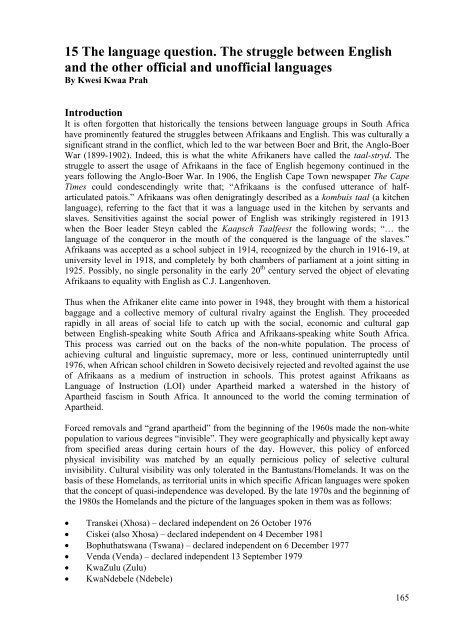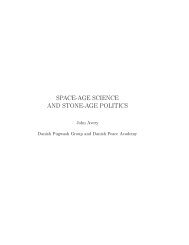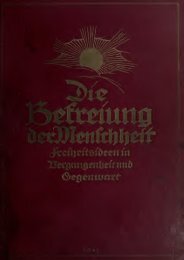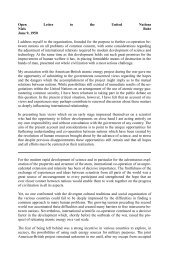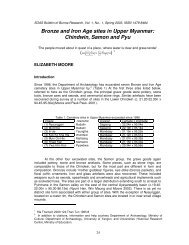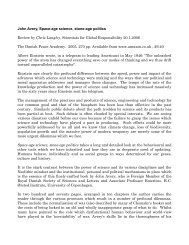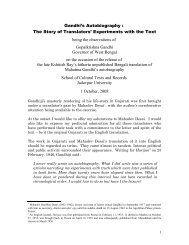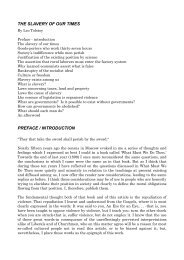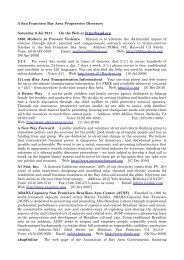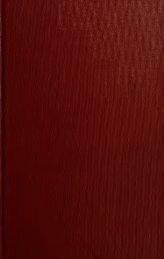History in the new South Africa: an introduction - Det danske ...
History in the new South Africa: an introduction - Det danske ...
History in the new South Africa: an introduction - Det danske ...
You also want an ePaper? Increase the reach of your titles
YUMPU automatically turns print PDFs into web optimized ePapers that Google loves.
15 The l<strong>an</strong>guage question. The struggle between English<br />
<strong>an</strong>d <strong>the</strong> o<strong>the</strong>r official <strong>an</strong>d unofficial l<strong>an</strong>guages<br />
By Kwesi Kwaa Prah<br />
Introduction<br />
It is often forgotten that historically <strong>the</strong> tensions between l<strong>an</strong>guage groups <strong>in</strong> <strong>South</strong> <strong>Africa</strong><br />
have prom<strong>in</strong>ently featured <strong>the</strong> struggles between Afrika<strong>an</strong>s <strong>an</strong>d English. This was culturally a<br />
signific<strong>an</strong>t str<strong>an</strong>d <strong>in</strong> <strong>the</strong> conflict, which led to <strong>the</strong> war between Boer <strong>an</strong>d Brit, <strong>the</strong> Anglo-Boer<br />
War (1899-1902). Indeed, this is what <strong>the</strong> white Afrik<strong>an</strong>ers have called <strong>the</strong> taal-stryd. The<br />
struggle to assert <strong>the</strong> usage of Afrika<strong>an</strong>s <strong>in</strong> <strong>the</strong> face of English hegemony cont<strong>in</strong>ued <strong>in</strong> <strong>the</strong><br />
years follow<strong>in</strong>g <strong>the</strong> Anglo-Boer War. In 1906, <strong>the</strong> English Cape Town <strong>new</strong>spaper The Cape<br />
Times could condescend<strong>in</strong>gly write that; “Afrika<strong>an</strong>s is <strong>the</strong> confused utter<strong>an</strong>ce of halfarticulated<br />
patois.” Afrika<strong>an</strong>s was often denigrat<strong>in</strong>gly described as a kombuis taal (a kitchen<br />
l<strong>an</strong>guage), referr<strong>in</strong>g to <strong>the</strong> fact that it was a l<strong>an</strong>guage used <strong>in</strong> <strong>the</strong> kitchen by serv<strong>an</strong>ts <strong>an</strong>d<br />
slaves. Sensitivities aga<strong>in</strong>st <strong>the</strong> social power of English was strik<strong>in</strong>gly registered <strong>in</strong> 1913<br />
when <strong>the</strong> Boer leader Steyn cabled <strong>the</strong> Kaapsch Taalfeest <strong>the</strong> follow<strong>in</strong>g words; “… <strong>the</strong><br />
l<strong>an</strong>guage of <strong>the</strong> conqueror <strong>in</strong> <strong>the</strong> mouth of <strong>the</strong> conquered is <strong>the</strong> l<strong>an</strong>guage of <strong>the</strong> slaves.”<br />
Afrika<strong>an</strong>s was accepted as a school subject <strong>in</strong> 1914, recognized by <strong>the</strong> church <strong>in</strong> 1916-19, at<br />
university level <strong>in</strong> 1918, <strong>an</strong>d completely by both chambers of parliament at a jo<strong>in</strong>t sitt<strong>in</strong>g <strong>in</strong><br />
1925. Possibly, no s<strong>in</strong>gle personality <strong>in</strong> <strong>the</strong> early 20 th century served <strong>the</strong> object of elevat<strong>in</strong>g<br />
Afrika<strong>an</strong>s to equality with English as C.J. L<strong>an</strong>genhoven.<br />
Thus when <strong>the</strong> Afrik<strong>an</strong>er elite came <strong>in</strong>to power <strong>in</strong> 1948, <strong>the</strong>y brought with <strong>the</strong>m a historical<br />
baggage <strong>an</strong>d a collective memory of cultural rivalry aga<strong>in</strong>st <strong>the</strong> English. They proceeded<br />
rapidly <strong>in</strong> all areas of social life to catch up with <strong>the</strong> social, economic <strong>an</strong>d cultural gap<br />
between English-speak<strong>in</strong>g white <strong>South</strong> <strong>Africa</strong> <strong>an</strong>d Afrika<strong>an</strong>s-speak<strong>in</strong>g white <strong>South</strong> <strong>Africa</strong>.<br />
This process was carried out on <strong>the</strong> backs of <strong>the</strong> non-white population. The process of<br />
achiev<strong>in</strong>g cultural <strong>an</strong>d l<strong>in</strong>guistic supremacy, more or less, cont<strong>in</strong>ued un<strong>in</strong>terruptedly until<br />
1976, when <strong>Africa</strong>n school children <strong>in</strong> Soweto decisively rejected <strong>an</strong>d revolted aga<strong>in</strong>st <strong>the</strong> use<br />
of Afrika<strong>an</strong>s as a medium of <strong>in</strong>struction <strong>in</strong> schools. This protest aga<strong>in</strong>st Afrika<strong>an</strong>s as<br />
L<strong>an</strong>guage of Instruction (LOI) under Apar<strong>the</strong>id marked a watershed <strong>in</strong> <strong>the</strong> history of<br />
Apar<strong>the</strong>id fascism <strong>in</strong> <strong>South</strong> <strong>Africa</strong>. It <strong>an</strong>nounced to <strong>the</strong> world <strong>the</strong> com<strong>in</strong>g term<strong>in</strong>ation of<br />
Apar<strong>the</strong>id.<br />
Forced removals <strong>an</strong>d “gr<strong>an</strong>d apar<strong>the</strong>id” from <strong>the</strong> beg<strong>in</strong>n<strong>in</strong>g of <strong>the</strong> 1960s made <strong>the</strong> non-white<br />
population to various degrees “<strong>in</strong>visible”. They were geographically <strong>an</strong>d physically kept away<br />
from specified areas dur<strong>in</strong>g certa<strong>in</strong> hours of <strong>the</strong> day. However, this policy of enforced<br />
physical <strong>in</strong>visibility was matched by <strong>an</strong> equally pernicious policy of selective cultural<br />
<strong>in</strong>visibility. Cultural visibility was only tolerated <strong>in</strong> <strong>the</strong> B<strong>an</strong>tust<strong>an</strong>s/Homel<strong>an</strong>ds. It was on <strong>the</strong><br />
basis of <strong>the</strong>se Homel<strong>an</strong>ds, as territorial units <strong>in</strong> which specific <strong>Africa</strong>n l<strong>an</strong>guages were spoken<br />
that <strong>the</strong> concept of quasi-<strong>in</strong>dependence was developed. By <strong>the</strong> late 1970s <strong>an</strong>d <strong>the</strong> beg<strong>in</strong>n<strong>in</strong>g of<br />
<strong>the</strong> 1980s <strong>the</strong> Homel<strong>an</strong>ds <strong>an</strong>d <strong>the</strong> picture of <strong>the</strong> l<strong>an</strong>guages spoken <strong>in</strong> <strong>the</strong>m was as follows:<br />
• Tr<strong>an</strong>skei (Xhosa) – declared <strong>in</strong>dependent on 26 October 1976<br />
• Ciskei (also Xhosa) – declared <strong>in</strong>dependent on 4 December 1981<br />
• Bophuthatsw<strong>an</strong>a (Tsw<strong>an</strong>a) – declared <strong>in</strong>dependent on 6 December 1977<br />
• Venda (Venda) – declared <strong>in</strong>dependent 13 September 1979<br />
• KwaZulu (Zulu)<br />
• KwaNdebele (Ndebele)<br />
165


